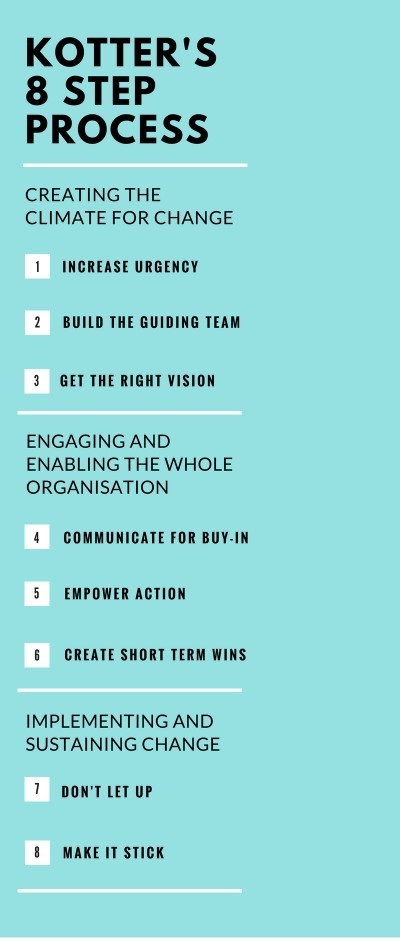
One thing we know for sure is that throughout our lives, change is constant. There will always be change happening either to us or around us, and we know that people respond differently to change for different reasons.
There is much in the literature about change, and I love learning about good models of change. I’ve previously written about the ADKAR model of change. The ADKAR acronym stands for Awareness, Desire, Knowledge, Ability, Reinforcement. You can read the article here.
Today I’ll be looking at a very influential model of change coined by John Kotter in his 1996 book called Leading Change.

In Leading Change, we get introduced to the Kotter eight step change model designed to help managers within organisations deal with transformational change.
Whilst the model is written primarily for organisational change, I believe we can all benefit from models of change such as this one, and use the principles within our own lives when we are trying to drive change or are experiencing change. You don’t need to be a manager within an organisation to benefit from understanding this model.
The Kotter 8 step model of change consists of steps that overlap. They broadly cover creating a climate for change, engaging and enabling the organisation, and lastly, implementing and sustaining change.

Let’s go through the model and each step in more detail. The first three steps all revolve around creating the right climate for change.
1 Create a sense of urgency
In order to create a climate for change, you must create a sense of urgency about what needs to happen. People need to want for the change to happen. The things that will put the lid on any change effort up front include complacency, self-protection, negativity and pessimism and immobilisation. To counter any of this, a sense of urgency about the need for change is required.
A convincing dialogue is required. To do this you might identify the potential threats and risks of not acting, the opportunities that the change can create, and the benefits that people will experience as a result of the change. You can also get support from others who want the change to help strengthen your argument.
This is one of the most important steps of the model, as without buy-in from the get go, your change effort may present significant challenges along the way.
2 Build the guiding team – form a powerful coalition
If you have created an appropriate sense of urgency, then forming the guiding team should come fairly naturally as it helps to bring the right people together. The team should include influential people who can work as a team and help build momentum and continue to build urgency around the need for change.
The team members don’t necessarily need to be senior within the hierarchy, but should have expertise and the ability to influence. If they have an emotional investment in the change, that’s even better. Be sure to check whether there are weaknesses in the team and pick members that can mitigate any weaknesses identified.

3 Create a vision for change
In this stage you need to be able to clearly articulate:
- The vision for the future
- Why the change is needed
- What needs to be done to realise the vision
A compelling case for change makes it easier for people to see the problems and their potential solutions.
In this step, some tangible things you can do include:
- Prepare a vision that describes an end state
- Develop a strategy showing how you will achieve the vision
- Develop step-by-step plans to deliver your strategy, against timelines and budget
4 Communicate for buy-in
You need to talk about the change at every opportunity you get. It needs to be communicated powerfully and frequently. The best communication is active dialogue. Not pushing facts and figures onto people, but engaging them in open and honest conversation. You must also ‘walk the talk’ here. Our behaviours must be consistent with our vision. There should be no gap between our words and our deeds.

5 Empower action and remove obstacles
By this stage, you’ve created a sense of urgency for the change and have a team of people to drive the change. You’ve created the vision, and are regularly communicating that vision. Hopefully you have the buy-in you need from people and their motivation behind the change to help it succeed.
Are there any people resistant to the change? Are there any barriers such as processes or structures getting in the way? Check for barriers, and if you find them, tackle them. Continue to remind people why the change is needed. Build motivation and inspiration through stories. Recognise and reward people who are supporting the change.
6 Create short term wins
Show that you are achieving results quickly by communicating and celebrating small wins regularly. You need to keep reinforcing that your change is moving in the right direction, and that people will see lots of wins as a result. The purpose of creating short term wins is to:
- Reinforce that the vision and strategy is valid
- Provide recognition and encouragement to those working so hard to achieve the vision
- Attract others who aren’t actively involved to get behind the change project
- Remove power from people who may be cynical about the project

7 Don’t let up
This step is about implementing the change and maintaining momentum. Activity needs to continue and not stop until the vision is a reality. Don’t let up.
Structures need to be created that empower people to take risks without fear. They need to be allowed to deal with problems openly and honestly in a constructive environment.
Each time you have a success with your change, use it as an opportunity to build on what worked and identify what could be improved.
Continue to set goals to build on the momentum you’ve achieved.
8 Make change stick
To make the change stick, change should become embedded in the culture of the organisation. New ways of working need to continue to be reinforced, ensuring that the old ways don’t creep back in.
Culture change needs to be embedded and reinforced through training and coaching. Desired behaviours need to be celebrated and rewarded.
Don’t give up until you get the needed behaviour and results.
According to Kotter, emotion is at the heart of change, and we see and feel change. Change should take a people-driven approach where people can see why change is needed, and will change if they are shown the truth because their feelings will have been influenced.
You can apply Kotter’s model to changes in a personal context as well, just use a different lens. For example, your guiding team might be members of your family and friends.
How have you experienced change? Have you used Kotter’s 8 step model? Leave me your comments and questions below and I’m happy to help.

Wow great article. Very motivating and easy to read!
Thanks Jonathan! It was fun to write too. I hope you got something out of it.
Thanks for stopping by.
Cheers
Melissa
Hi
Nice article, really smooth and readable. Hope to implement these in my life at some point.
Thanks
Hi Tahla, thanks for your feedback on my post. I hope this was helpful to you and I wish you all the very best.
Cheers
Melissa
This is the formula for helping the universe manifest whatever you want in your life , right? It seems like that. I mean for me, my sense of urgency is the fact that I am on welfare and that it expires in december, meaning if I dont find a means of income for myself, I will have to go to some crappy job I hate and have to put my son in community daycare… so because I am so NOT ABOUT THAT, I am deciding to change my life and make change by creating a vision of change FOR MYSELF. I see myself as a successful, single mom and able to make an income online without having to work for someone else. Without having to succumb to the human services agency who has been supplying me with my monthly $500 check – this isn’t enough for me! I will not accept this! I am empowering action and removing obstacles by teaching myself about my options in online income. I am learning about the ways I can make it out of this situation of poverty and relying on the government by utilizing my laptop and the free time I get while my son takes a nap or goes to bed for the time. That is time to get cracking! This is the time I create my little short term wins by posting once a day, updating my social profiles and promoting my stuff, of course I cant make a business and have traffic come to it and create income OVER NIGHT, it takes those little steps overtime and the VISION of it to put out in the universe for that extra kick of luck. Don’t let up means Don’t give up! Don’t quit! Cause if you do, then all that work you put in was for vain. Finally make that change consistent and STICK and you will eventually find yourself at the pot of gold you have been dreaming of.
Hi Sophia, you sound driven, strong and motivated and by the way you write I have a sense that you will succeed in life. You sound like you know what you need to get there. I know so many mums (me included!) who take every opportunity we can when we’re not being hands on with our kids. As you say, it’s time to get cracking!
Thanks so much for your insights and comment. Your story is wonderful and I know you will stick to your goals and your vision for change.
I wish you all the very best.
Cheers
Melissa